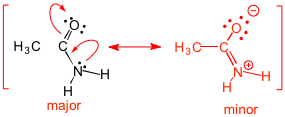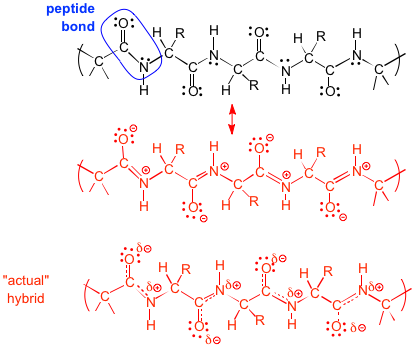
Minor resonance is important to your Real Life
Here is a tricky question: What is the hybridization of the nitrogen in the structure below (this is an amide functional group)?

This is tricky because we need to ask if we should include the presence of resonance contributors before assigning hybridization, such as that shown below. Normally the additional resonance contributor would be considered very minor, since it separates charges, and according to the Coulomb law that costs energy. However, if a resonance contributor HAS to separate charges, this is about as good a way as it can happen. The formal number of double bonds is at least the same, and the negative charge is on oxygen and the positive charge is on nitrogen, which is the best way to separate the charges on these two atoms. So maybe the minor contributor isn't as minor as other minor contributors? It turns out that yes, this one isn't too minor at all and it needs to be considered when discussing the chemistry of the amide functional group.

The minor contributor has a formal double bond between the C and N atoms, and there are several situations where this partial C=N double bond character turns out to be important. One of them is in the structure of proteins.
We can't get into a lot of detail about protein structure, this is a big subject, other than to say that they are polymers of compounds called amino acids. When the amino acids polymerize they make so-called peptide bonds, which are in essence the amide functional group. In other words, what holds proteins together are amide bonds. This turns out to be important for the secondary structure of proteins.
We can't get into a lot of detail about protein structure, this is a big subject, other than to say that they are polymers of compounds called amino acids. When the amino acids polymerize they make so-called peptide bonds, which are in essence the amide functional group. In other words, what holds proteins together are amide bonds. This turns out to be important for the secondary structure of proteins.

When we take into account the minor resonance contributors we see that the double bond character is extended over the extended structure, which tends to restrict rotation around the bonds that would normally be considered to be single bonds. This gives the polymer a "stiffness" that is one of the factors that contributes to determining the shapes of proteins and the way that they fold. There is a lot more to understanding protein structure than we just mentioned here, but one of the factors does connect to the resonance phenomenon we learn about in our class, and protein structure and folding are critical to just about all life processes, including yours!